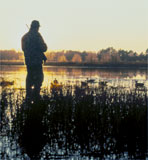| Contact us |
| Try wildfowling |
| Club merchandise |
| Wildfowl art |
| Wildfowling books |
| Join KWCA |
| Search |

Wildfowling
An introduction
To be a successful wildfowler a man must have
particular qualities not found in those who participate in other shooting
pastimes. Not for him the cosy pigeon shooting hide, the convenience of
the driven pheasant or the certainty of the clay pigeon.
His sport takes place in the wild and lonely
expanse of the inter-tidal zone, in muddy creeks and deep gutters, amongst
the saltings and spartina grass. He will endure hardships and risks unknown
to those who shoot the moors and woodlands. Lying in wait in the darkness
and bitter cold, shooting from cramped positions with numb fingers, and
with feet and legs trapped in an unforgiving ooze for a single shot that
will test even the best of men.
Long hours will be spent learning the habitat and habits of the wondrous
creatures he pursues, distinguishing their many and varied calls, understanding
what individual notes mean and masterfully calling back to them luring
them within range of his gun.
Encountering a huge variety of birds, he must be able to identify them
by call and wing beat alone, judge their range in an instant and in poor
light and extreme weather conditions. His quarry flies mainly in the half-light,
at dusk or dawn and in the moonlight. His best chances are dependent on
weather conditions and may come when the wind is in the east coming from
somewhere bitterly cold but he must be able to decide what each species
of bird will do under varying conditions of weather and tide. The wildfowler
experiences many of the splendors of nature as he lies in wait on his
mystical marshlands. The magnificence of the winter dawn and sunrise,
of bright moonlit nights full of sounds, strange calls and cries that
ordinary folk never hear. The rush of air spilling from the wings of the
plover as they race through the sky, the melancholy notes of the curlew
as dawn breaks and the marshes awaken, the evening sky full with the melodious
whistles from pintail, teal and wigeon as they pass high overhead on route
to their feeding grounds, magical notes of the wild geese and the ghostly
call of the bittern are sounds familiar to the wildfowler but denied to
those who slumber in their beds.
The wildfowler has at his disposal a far greater armoury than other sportsman.
From the 3 1/2" chambered magnum 12 bore guns though 8 bores and
4 bores to massive puntguns weighing 100 kilograms. His knowledge
of ammunition calls for a far more comprehensive understanding than
is necessary for the common person. With lead gone, the wildfowler must
be familiar with steel, tin, bismuth and tungsten, and loads ranging from
the normal 32 grams to an enormous 800 grams.
Uncertainty and anticipation are a fascination of wildfowling, and when
patience and endurance are rewarded, even the smallest bag gives great
pleasure.
Join the Kent Wildfowlers today